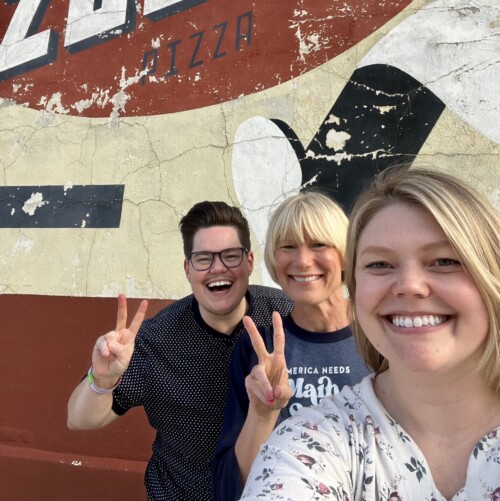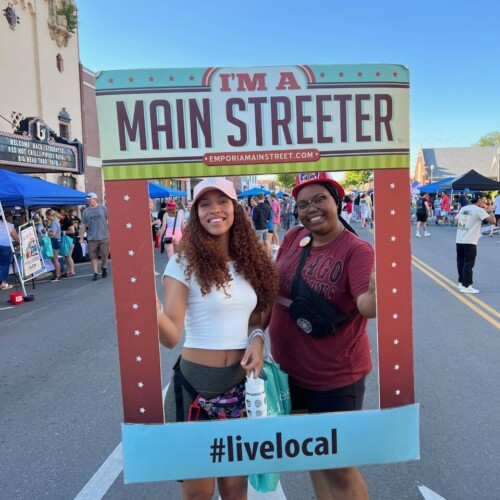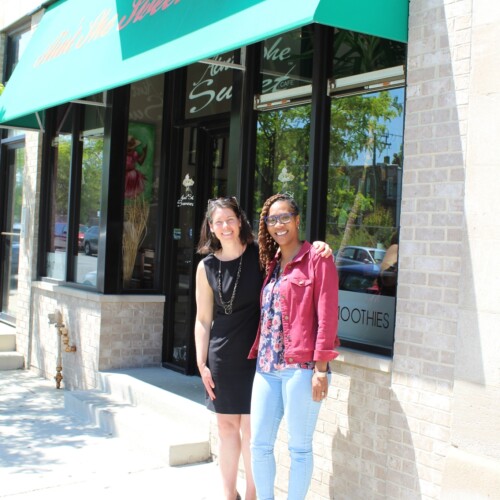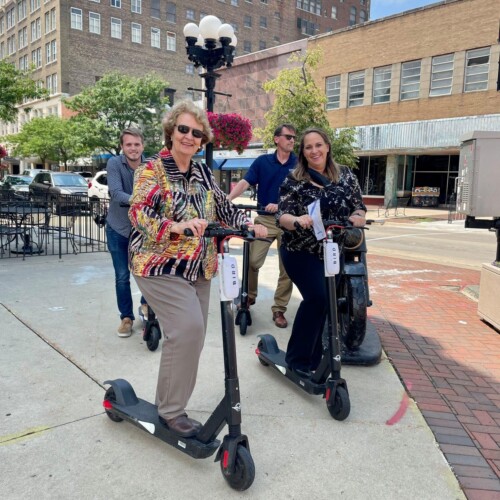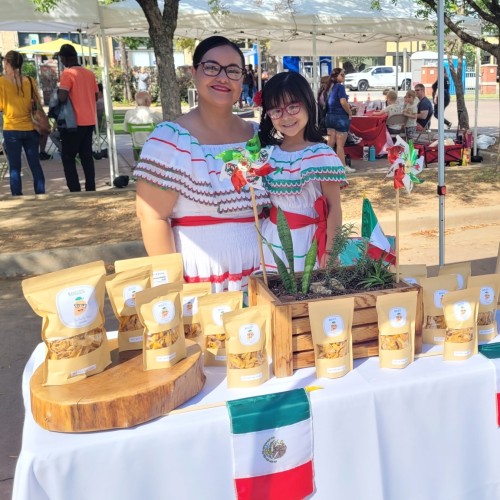November 10, 2020 | Main Spotlight: Developing a Toolbox to Help Manage Growth on Main Street | By: Kim McAuliffe, Downtown Development Manager, City of Georgetown
Aerial shot of Downtown Georgetown. Photo credit: City of Georgetown
When looking to the future and how to appropriately manage community growth, it is vital to have development tools in place. Over the years, the City of Georgetown has worked hard to maintain its character while also maximizing opportunities for economic development and for enhancing the quality of life for its residents. It has been a city council priority to manage growth through implementing a toolbox of resources for our city.
Georgetown has encountered explosive growth over the past 10 years. The population has doubled from 35,000 to over 70,000 since 2010 and the city has been included in the list of top 10 fastest growing cities in the U.S. with a population over 50,000 in the last 5 years. Without the proper tools and resources in place, the city would likely be unprepared to manage this growth and the new developments that come along with it.
As an almost 40-year participant in the Main Street Program, Georgetown has developed a strong Downtown Master Plan that helps serve as a guide-point for planning efforts in downtown. In addition to the Master Plan, the city worked to establish Downtown Design Guidelines, a Main Street Façade & Sign Grant Program, and numerous studies that allows staff to better know the existing resources and what resource areas need to be better addressed.
Downtown Master Plan
The first Downtown Master Plan was created in 2003 and most recently updated in 2013 with another update to the plan on the horizon. The Master Plan provides a framework for Georgetown to use in planning for the future of downtown. Many planning decisions have been made carefully, with close consideration of the impacts and benefits of development and recognition of long-term city policies. The importance of current decisions spurred by recent growth and of maintaining the small-town character of the downtown is evident in community involvement in the planning process.
The Master Plan implementation strategies include coordinated efforts between public and private entities through a proactive and responsive approach. It also includes suggested catalyst projects and strategic planning within the annual CIP plan.
City leaders established a cross-departmental “Downtown Team” to tackle these strategies. The team includes staff from the Economic Development Department, Convention and Visitor’s Bureau, Planning Department, Public Works Department, Engineering Department, Arts and Culture Department, and Communications Department. The benefits of this team come from the diverse experiences and perspectives each member brings to the table. The team-based approach has paid off in dividends as evidenced by the successes seen in downtown since its establishment.
Storefronts along Austin Avenue. Photo credit: City of Georgetown
Downtown Design Guidelines
With the creation of the Master Plan, the need for a companion document with guidelines for redevelopment and new development was needed. In 2012, as the community started to see an even greater uptick in growth patterns, the Downtown and Old Town Overlay Design Guidelines were established to prepare for the growth that would come in both downtown and the surrounding Old Town neighborhood. The Design Guidelines are for property owners planning exterior alterations or the rehabilitation of existing buildings. They also apply to the design of new buildings.
The Design Guidelines are intended to assist property owners in understanding the historic character of the buildings and environment in which they are located when they are faced with decisions about repair, maintenance, rehabilitation, and new construction. They are not a rigid set of rules and do not require that buildings be restored to a particular historical time period or style. The Design Guidelines help the community to maintain the unique character through a thoughtful approach to development and redevelopment.
Main Street Façade & Sign Grant Program
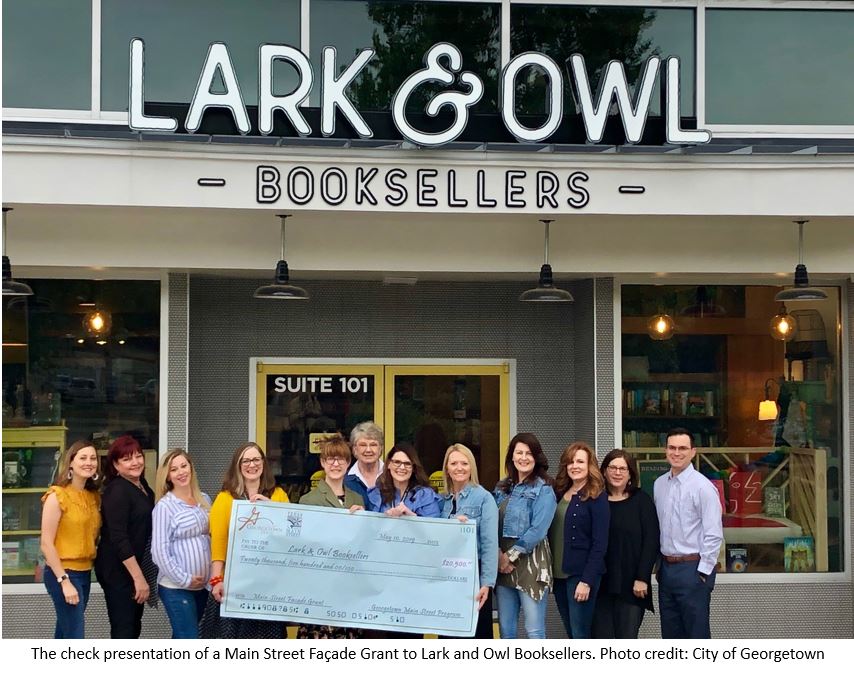 With a Master Plan in place, the City knew where it wanted to go, but once again saw the need for another tool in their resource toolbox. In 1998, a council resolution was passed to create a Main Street Façade Fund to be used on façade improvements to the buildings in downtown. The first few years were spent building the fund balance and in 2004, the first five awards were granted at just over $17,000 total.
With a Master Plan in place, the City knew where it wanted to go, but once again saw the need for another tool in their resource toolbox. In 1998, a council resolution was passed to create a Main Street Façade Fund to be used on façade improvements to the buildings in downtown. The first few years were spent building the fund balance and in 2004, the first five awards were granted at just over $17,000 total.
The grant program has grown since that time, and in 2019 the Main Street Board granted over $70,000 in awards bringing the total grant investment in downtown properties to over $500,000 in the last 15 years. The grant program now covers roof repairs and replacement, foundation work, ADA improvements, and fire suppression. Anything that can help extend the life of a historic structure is covered under the grant program. Nearly every building on the courthouse square has benefited from a grant, and more applications have been considered in recent years for properties off the square which helps extend the beauty of the restored downtown.
Retail Study
In Georgetown, Main Street is part of the Economic Development Department in the City. As such, the strategies for development are targeted and based upon a retail study that was conducted in 2016. The benefits of having a retail study helps staff better understand the community’s overall business mix and where there is “leakage” in the market. With the retail study, staff has developed targeted recruitment strategies with successful results.
Parking Study
One thing that every downtown professional, business, or developer can agree on is that there will never be enough parking in downtown, whether that problem is real or perceived. A walking problem is more likely the challenge in most communities, but the perception that downtown has no parking will almost always exist.
In 2015, with continued redevelopment, a parking study was conducted to identify and put together a plan to address parking concerns. The plan has been very helpful for staff to better understand where problems exist and work on a phased approach at addressing short-term and long-term improvements in this area.
Adequate parking and sidewalk availability creates space to support the town's classic events, such as the Georgetown Swirl (left) and the Blazin Beer Crawl (Right). Photo credit: City of Georgetown
Sidewalk Master Plan
During the same time the parking study was being conducted, a Sidewalk Master Plan was developed to help with planning for upgrades to inadequate infrastructure, funding mechanisms, and similar short-term and long-term improvements. If the city wanted to properly address concerns over parking, they needed to also address alternative forms of transportation in and around downtown.
Projects identified in this plan are still being implemented on an annual basis based on funding allocations and construction timelines. Without this plan, there would not be a clear priority for where sidewalks were needed, what areas needed repair, and what ranked the most important for CIP timing purposes.
The Importance of Good Planning
Without a plan in place, how does a community know where it wants to go? It’s been a long road for Georgetown to get to where it is today. A key piece to successful community development is great leadership and great planning. The commitment to downtown revitalization has always been the guiding light for this community. The city council’s vision statement captures the spirit of the community best, Georgetown: a caring community honoring our past and innovating for the future.
About Kim McAuliffe
Kim is the Downtown Development Manager for the City of Georgetown. In her role, she is responsible for managing the Main Street Program and the economic development efforts in the Downtown Overlay District, including business retention and expansion as well as new business recruitment. Kim serves as a staff liaison and resource for small businesses working through the development process in the downtown district.
About Georgetown
Georgetown is a community of around 70,000 located approximately 26 miles north of Austin. Known as the Most Beautiful Town Square in Texas as well as for its rich history, Georgetown has over 180 homes and buildings listed on the National Register of Historic Places. It was the recipient of the Great American Main Street Award in 1997, the first Texas city honored with that recognition. Georgetown is also the recipient of the First Lady’s Texas Treasures Award and the Downtown Historic District was most recently named a Great Places in America, Best Neighborhood from the American Planning Association.
